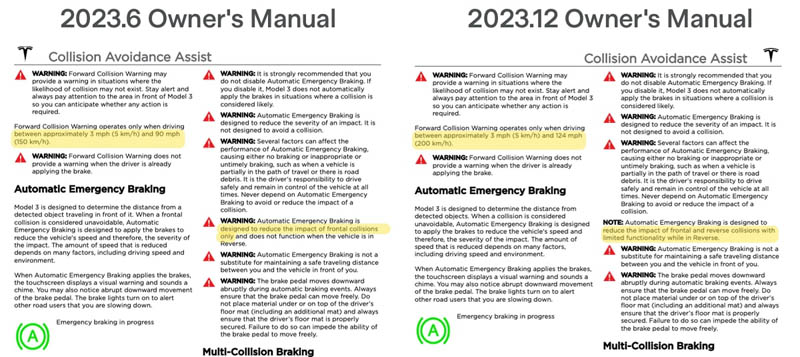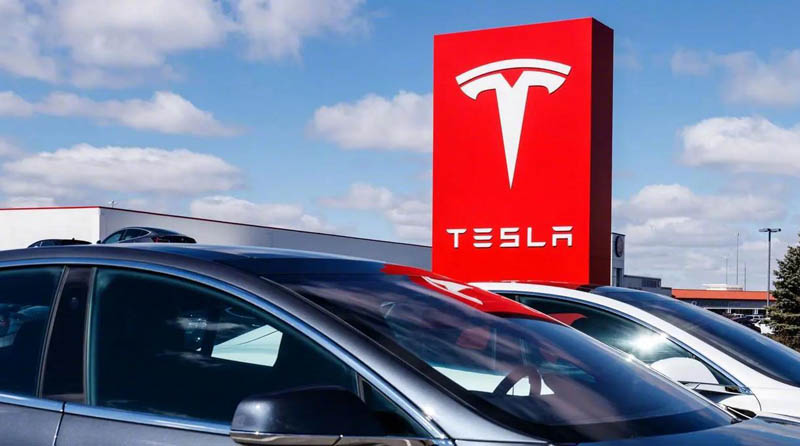Tesla has announced an update to its user manual, revealing that with OS v2023.12 and above, its Automatic Emergency Braking (AEB) system can now be used at higher speeds and in reverse. The AEB system can now operate between approximately 3mph (5 km/h) and 124 mph (200 km/h), increasing the top speed of the previous version which was limited to 90 mph (150 km/h).
Not only increased speed range, the updated AEB system now works when the vehicle is in reverse, improving safety and convenience for drivers. This update is a significant improvement over the previous version of the AEB system, and demonstrates Tesla’s commitment to continuously improving its safety features.

What is Automatic Emergency Braking (AEB)?
Automatic Emergency Braking is a safety feature that uses sensors and cameras to scan the road ahead for potential collisions. When the system detects an imminent collision, it will apply the brakes to prevent or mitigate the impact. AEB technology has been widely adopted by automakers in recent years, and has been shown to significantly reduce the number of accidents caused by human error.
Improving Safety with Higher Speed Range
With the updated AEB system, Tesla vehicles can now detect potential collisions at higher speeds. This is a significant improvement over the previous version of the AEB system, which was limited to a top speed of 90 mph (150 km/h). The increased speed range means that the AEB system can now detect and prevent collisions at highway speeds, improving safety for drivers and passengers.
The updated AEB system also works when the vehicle is in reverse, providing an additional layer of safety for drivers. This is particularly useful when parking or maneuvering in tight spaces, where the risk of collision is higher. With the AEB system now operating in reverse, drivers can have peace of mind knowing that their vehicle is equipped with the latest safety technology.
Limitations of AEB Technology
While AEB technology is a significant improvement over traditional braking systems, it is not foolproof. There are several limitations to the AEB system that drivers should be aware of.
Quickly turning the steering wheel: If the driver turns the steering wheel quickly, the AEB system may not be able to apply the brakes in time to prevent a collision.
Depressing and releasing the brake pedal: If the driver depresses and releases the brake pedal while the AEB system is applying the brakes, the system may not be able to stop the vehicle in time to prevent a collision.
Accelerating hard: If the driver accelerates hard while the AEB system is applying the brakes, the system may not be able to stop the vehicle in time to prevent a collision.
No objects detected: If the AEB system does not detect any vehicles, motorcycles, bicycles, or pedestrians ahead, it will not apply the brakes.
Tesla’s Commitment to Safety
Tesla is known for its commitment to safety, and this latest update to the AEB system is a testament to that commitment. Tesla’s vehicles are equipped with a variety of safety features, including Autopilot, which can assist drivers with steering, accelerating, and braking.
Related Posts: Tesla Q1 Earnings Call: Key Takeaways, Elon Musk’s vision for the company’s future.
Tesla’s active safety performance has been recognized by major collision agencies around the world, including the National Highway Traffic Safety Administration (NHTSA) and the European New Car Assessment Programme (Euro NCAP). Tesla’s vehicles consistently receive top marks in crash tests and safety ratings, making them some of the safest vehicles on the road today.
Increased speed range and reverse AEB capabilities demonstrate Tesla’s commitment to continuously improving its safety features. While the AEB system is not foolproof, it is a significant improvement over traditional braking systems and has been shown to significantly reduce the number of accidents caused by human error.
